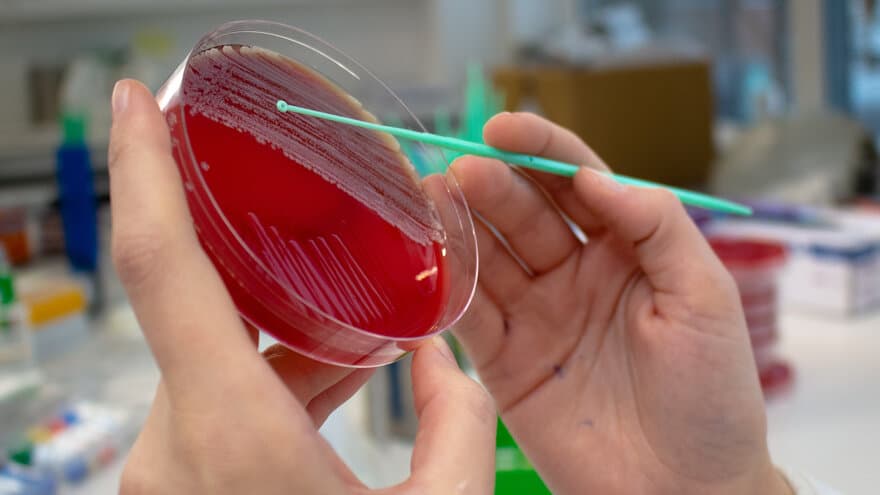About our unit
We teach veterinary and veterinary nursing students in bacteriology, mycology and infection control. In addition, we teach scientific publishing and contribute to the National Graduate School in Infection Biology and Antimicrobials (IBA).
Furthermore, we supervise projects for bachelor students (veterinary nursing studies, engineering studies), master's students, veterinary specialization and research line students and PhD students. We currently have six PhD students, three research line students and two bachelor students affiliated with our Unit.We run a quality-assured laboratory that performs tests for the identification of bacteria and fungi in samples from production animals, horses, pets and bees, as well as the presence of bacteria in water systems such as aquariums and fish tanks.
The laboratory is led by Sabrina Rodriguez Campos and run by bioengineers and veterinarians from our group. In June 2022 our laboratory was approved as a Training Center av den European College of Veterinary Microbiology, with Dr. Sabrina Rodriguez Campos (DipECVM) serving as supervisor.
services:
Laboraturium and diagnostics
Ongoing research projects
In the autumn of 2019, we observed an increase in cases of acute hemorrhagic diarrhea syndrome (AHDS) in dogs in southeastern Norway. The bacterium Providencia alcalifaciens was isolated from these dogs in unusually high incidence, often together with Clostridium perfringens.
In collaboration with NMBU Small Animal Hospital, the Norwegian Veterinary Institute and the Waltham Petcare Science Institute, we aim to understand whether P. alcalifaciens may have a possible role as a causal agent for AHDS in dogs.
Involved from us: Eiril Soltvedt, Sabrina Rodriguez Campos, Simen Foyn Nørstebø, Helene Karlsen, Anja Aardal
Read more on the project page.HUNT One Health is a sub-project of HUNT4, a collaborative project between HUNT / NTNU, the NMBU Favulty of Veterinary Medicine and the Norwegian Veterinary Institute.
The main purpose of the project is to help understand how the microbial community in animals interacts with the microbial community in humans and in the environment. The project is based on the collection of faecal samples from animals belonging to participants in HUNT 4.
The samples are examined via metagenomics by mapping all microbial DNA found in the samples. The results should be compared with a similar examination of faecal samples from humans in HUNT4.
Involved from us: Ane Mohn Bjelland, Mari Røken, Sabrina Rodriguez Campos, Simen Foyn Nørstebø.
Atlantic cod lacks MHC class II, an important part of the adaptive immune system in mammals with significance for how the immune system perceives antigens from, among other things, bacteria.
The cod still has a functional immune system and achieves specific protection against disease after vaccination. The project is led by UiO and seeks to understand the cod's immune system using new, molecular tools.
Our group contributes with an infection model for vibriosis. Involved from us: Simen Foyn Nørstebø, Henning Sørum.
Read more on the Research Council of Norway's pages.Increased sustainability and animal welfare in the cattle industry by reducing respiratory disease and the use of antimicrobial agents.
Involved from us: Ane Mohn Bjelland, Aleksandra Bodura Göksu.
Leptospirosis is a notifiable B-disease caused by the spiral bacterium Leptospira and which can occur in various animal species and in humans. According to the World Health Organization (WHO), leptospirosis is one of the most important (re-) emerging infectious diseases worldwide.
Rats and other rodents can be a natural reservoir. We aim to clarify the role of possible hosts for the disease in Norway and to better understand the virulence mechanisms of these bacteria.
Involved from us: Silje Hansen, Aleksandra Bodura Göksu, Sabrina Rodriguez.In many countries, subclinical endometritis is an important cause of reduced fertility after insemination of cattle, but the incidence of subclinical endometritis in Norwegian red cattle (NRF) is not known.
NMBU Faculty of Veterinary Medicine and Geno have initiated a project to map the occurrence and significance of subclinical endometritis in NRF cows, and our group contributes with characterization of microbiota in the endometrium to investigate whether bacteria can be a contributing factor to subclinical endometritis.
Involved from us: Simen Foyn Nørstebø.
The project is a collaboration between researchers in Ireland, France, the United Kingdom and Norway, and aims to increase sustainability in sheep production, among other things by developing better methods for artificial insemination of sheep.
Our group contributes with investigations of the microbiota in the cervix to increase the understanding of various factors with possible significance for the transport of sperm through the cervix to the uterus.
Involved from us: Sabrina Rodriguez Campos, Simen Foyn Nørstebø, Özgün Candan Onarman Umu
